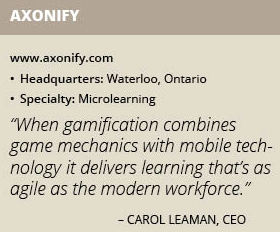
The Future of Manufacturing Workforce Training: Embracing Gamification for Success
The manufacturing industry is changing. It’s becoming increasingly complex.
Manufacturers across all sectors are exploring ways to integrate new materials and processes to help them do everything—from streamline operations to deliver innovative products and create new paths to increased revenue. And for good reason. In the highly competitive world of manufacturing, product and service differentiation delivers a much-needed advantage.
While all this change creates opportunities for manufacturers, it’s not without its challenges.
Expectations are Changing
Consumers and stakeholders expect more. Consumers want customized, high-quality products—and they want them now. Business stakeholders want increased yield, decreased safety incidents and shortened production cycles—and they want it all while maintaining quality, reducing costs and remaining competitive.
All this is putting an immense amount of pressure on your workforce. In fact, your employees need to know more than ever before. And, as modern technology continues to accelerate the pace of change, it only increases the skills and knowledge employees need to perform.
To further complicate things, the nature of the workforce is changing.
The evolving workforce and widening skills gap
Although millennials represent the largest generation in the workforce, baby boomers still make up the largest worker demographic in manufacturing. Currently, more than a quarter of manufacturing workers are over the age of 55. As these seasoned employees retire at a rate of 10,000+/a day (in the U.S. alone), they take their decades of knowledge and skills with them and leave unfilled positions behind.
When you combine the boomer exodus with the speed and radical transformation in manufacturing, you create a skills gap, which will only continue to grow. Despite there being more than enough millennials to fill these positions, manufacturers are struggling to attract this younger demographic. Research suggests more than 2 million U.S. manufacturing jobs will go unfilled over the next decade. This is prompting manufacturers to look elsewhere for new talent, with up to 16% of new hires coming from non-manufacturing sectors.
The challenge is to make sure this increasingly diverse workforce—comprising employees across generations, cultures and, now, even industries—has the knowledge and skills they need to operate at peak levels. If your workforce can’t reach its full potential, you can’t maximize the returns on the investments you’ve made to modernize your organization and get ahead of the competition.
A new game plan
It’s obvious that when your employees perform better, your business does too. What’s not as obvious is how to motivate your workforce. How do you ensure they learn what they need to know and do on the job so they’re more productive?
In order to transform frontline employees into top performers, you need a training solution that is as dynamic and agile as your workforce. But, the reality is, even the most sophisticated training solution won’t work if employees don’t want to use it.
You need a new game plan to get your frontline to participate in training so they have the information they need to be top performers (and you don’t waste valuable resources on a solution that doesn’t work).
With the right motivation tools in place, you can drive engagement, and thereby, learning. Wrapping training in gamification is an effective method that taps into the human psychology of motivation.
Motivation for the win
Gamification is the process of making non-game activities (like traditional, lecture-style classroom training) more fun and engaging. Karl Kapp, a leading expert on the convergence of learning and technology, defines gamification as a careful and considered application of “game-based mechanics, aesthetics and game thinking to engage people, motivate action, promote learning, and solve problems.”
Gamification may sound counterintuitive, and many leaders balk at the idea of “paying their employees to play games on the job.” Yet most won’t hesitate to mandate lengthy sessions that take workers away from their jobs for hours (or days) on end to participate in training that doesn’t engage workers very effectively. One-time, event-based learning delivers too much information at once and fails to reinforce learning over time to ensure the information sticks. In fact, on average, people forget 70% of what is taught within 24 hours of the training experience.
Conversely, gamification uses all of the best attributes of games that bring out people’s natural desire for competition, achievement, status, self-expression, altruism and closure. People participate in learning activities that include game elements such as earning points, overcoming a challenge or receiving badges for accomplishing tasks; but without the rigid (and often time consuming) start-stop, win-lose structure of a traditional game.
The right mix of mechanics
Gamification motivates employees to participate (and, thereby learn) and drives engagement using the following mechanics:
- Points and rewards: A points/rewards system satisfies the wants and needs of employees by answering the question, “What’s in it for me?” It’s the carrot that entices them to participate and go the extra mile. Points/rewards also give them a goal to work towards. The more training they complete, the more points they earn. And the more points they earn, the more rewards they reap (such as company swag, a gift card or even a vacation day).
- Leaderboards: Leaderboards tap into a healthy competitive spirit among coworkers. Showing individuals or teams how they stack up against each other encourages users to try harder, promotes participation, and gets people socializing and collaborating to win challenges as a team. Leaderboards are also a source of positive reinforcement. When your employees have a visible marker for progress, they can see what they’ve completed and how far they’ve come, which gives them a sense of accomplishment.
- Games: Giving your employees the option to play games at work might feel counterproductive, but the games themselves are what make gamification work so well. They essentially “trick” employees into learning, because they make it fun. Driving up the fun factor is what hooks employees. For most, learning is simply a happy by-product of playing a fun game. But the fun factor is what keeps them coming back so that they’re always learning new things—whether they realize it or not.
When your workforce is actively (proactively, even) engaging in training, they’re rewarded on two levels: intrinsically, by the satisfaction they get from their accomplishments and development, and extrinsically, by the tangible prizes they get for participating. No matter what drives them to participate it’s a win/win. Your employees are motivated to learn more, and that’s good for your business.
When gamification combines game mechanics with mobile technology it delivers learning that’s as agile as the modern workforce. It also happens to deliver three things that those hard-to-attract millennial employees value most: rewards, recognition and ongoing professional development.
Because gamification can be mobile, it allows your frontline to engage in learning when and where it’s most convenient for them. This is also where you see the best results: in real-world environments, where training is delivered in context.
Since gamified information is generally distributed in shorter bursts over a long period of time (and not meant to be learned in one go), you don’t have to choose between keeping your people learning or production moving. So, a machine operator, for example, can squeeze in a quick 3-minute lesson about troubleshooting a new piece of equipment on a shared terminal or tablet at the beginning of a shift. That way, if the machine unexpectedly fails, the operator has the knowledge needed to get the machine up and running quickly to maximize availability, minimize downtime and mitigate the overall impact to your operation.
When learning can be done on the shop floor, in the breakroom or anywhere that makes sense in the employee’s workflow, it creates endless opportunities for them to continuously improve their on-the-job performance.
A true game changer
Gamification gives you a way to bring both your workforce and your training into the future. It enables you to accelerate onboarding and then keep continuous employee development going with customized content. It gives you the ability to upskill your employees as change happens, so your workforce can keep up with the dizzying pace of business. The faster you get your workforce to where you need it to be, the faster you’ll be able to realize returns on your training and other CapEx investments.
Gamification is a true game changer. It provides the tools required to motivate employees to perform better everyday. With a smarter, more productive workforce, you can improve quality, productivity and profitability while driving operational excellence.
In such a competitive industry, this means it’s game over for your competition.
Carol Leaman, CEO at Axonify Inc., is an award-winning thought leader and celebrated entrepreneur with an impressive track record of successfully leading tech companies. Prior to Axonify, Leaman was the CEO of PostRank Inc., a social engagement analytics platform she sold to Google. You can read more from her on Training Industry Magazine, ATD, CLO and Fortune. You can always reach Carol at cleaman@axonify.com.